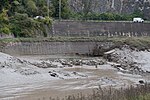St Peter's Church, Castle Park, Bristol

St Peter's Church is a ruined church in Castle Park, Bristol, England. It was bombed during World War II and is now preserved as a memorial. The foundation of the church can be traced back to 1106 when it was endowed on Tewkesbury Abbey, with a 12th-century lower tower, the rest of the church being built in the 15th century. Excavations in 1975 suggest that this was the site of Bristol's first church; the 12th-century city wall runs under the west end of the present church. It was bombed during the Bristol Blitz of 24–25 November 1940 and ruined. It is maintained as a monument to the civilian war dead of Bristol. It has been designated by English Heritage as a grade II* listed building.The church ran St Peter's Hospital, a workhouse located between the church and Floating Harbour which was destroyed by bombing during the Bristol Blitz.
Excerpt from the Wikipedia article St Peter's Church, Castle Park, Bristol (License: CC BY-SA 3.0, Authors, Images).St Peter's Church, Castle Park, Bristol
Newgate, Bristol Broadmead
Geographical coordinates (GPS) Address External links Nearby Places Show on map
Geographical coordinates (GPS)
| Latitude | Longitude |
|---|---|
| N 51.4553 ° | E -2.5897 ° |
Address
St Peter's Church
Newgate
BS1 3XX Bristol, Broadmead
England, United Kingdom
Open on Google Maps









